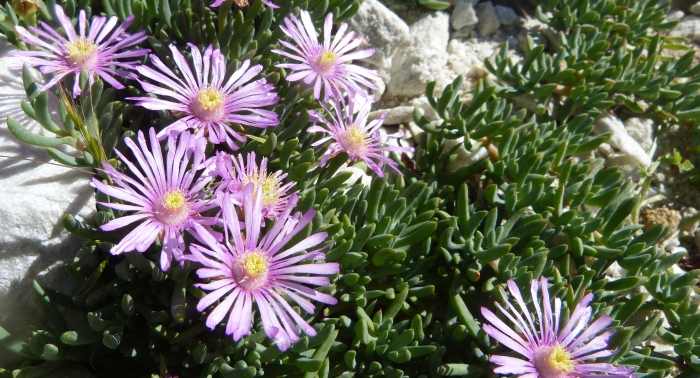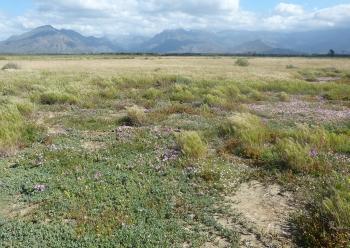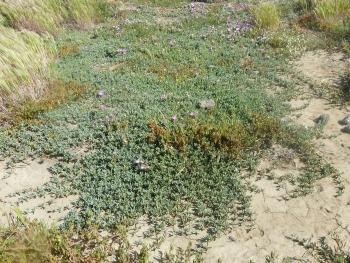Lampranthus tegens
Lampranthus tegens (F.Muell.) N.E.Br. ( = Lampranthus caespitosus (L.Bolus) N.E.Br.)
Family: Aizoaceae
Common names: mat-lampranthus (Eng.); matvygie (Afr.)
Introduction
A flat-growing, mat-forming, leaf succulent, often rooting at the nodes, and an easy-to-grow, drought tolerant plant for fynbos gardens, especially on a solid clay surface.

Description
Description
Mat-forming perennial, seldom higher than 20 mm.Branches procumbent, the central branch elongating, and longer than the shorter side branches, rooting at the nodes. Main branch up to about 6 mm in diameter, terete, grey-brown, the younger branches somewhat flattened, orange-brown. The internodes on the elongating branches about 20 mm apart. The lateral branches with leaves crowded and internodes very short and not visible, the tips often decumbent.

Flowering branches ascending. Leaves ascending-spreading opposite, connate at the base, sub-falcate, glaucous, about 10 mm long, triquetrous, about 2.0–3.5 mm in diameter, the apex acute. Leaves on lateral branches 6–7 × 2.5 mm. Flowers solitary in the leaf axils, on slender petioles, 10 to 22 mm in diameter, pink. Flowering time is late spring (October to November).

Conservation Status
Status
Lampranthus tegens is rarely seen in cultivation and wild populations on the Cape Flats and Paarden Island have become very rare, because of urban expansion and farming activities. The odd surviving population only becomes conspicuous during flowering time. Some of the populations also grow next to the N1 Highway between Cape Town and Paarl. Its conservation status in the Red List of South Africa was given as DDT, which means it is Data Deficient.

Distribution and habitat
Distribution description
Lampranthus tegens is endemic to the winter-rainfall region of the Western Cape, South Africa. It is confined to flat areas with clay soil, forming mats in open areas, among fynbos plants. It has been recorded from Paarden Island to Worcester, but always associated with a hard clay surface.The average daily maximum is 22–24ºC and the average daily minimum 10–12ºC. In some parts near Worcester the plants are locally abundant.

Rain falls mainly in winter (mainly May to October) and averages between 250 and about 600 mm per annum. The summers are dry and very hot in areas away from the coast. Winters are cooler and if frost occurs, it is very light and occurs over short periods.
Derivation of name and historical aspects
History
Lampranthus tegens has an interesting history. It was named by the botanist, F. Mueller in 1866 from near Melbourne (Australia) as Mesembryanthemum tegens. It was later transferred to the genus Lampranthus by N.E. Brown, in 1930. Wooley Dodd, however, also recorded the plant from Paarden Island on the Cape Peninsula (Western Cape), in 1897. Brown commented that the plant was probably per accidentally transferred from Melbourne to Paarden Island (Hartmann 2001). However, today we know it is definitely indigenous to the Western Cape and rather the reverse should be true. Louisa Bolus named her specimen found growing in Paarden Island. Mesembryanthemum caespitosum in Notes of the Bolus Herbarium, in 1920. N.E. Brown also transferred the species to Lampranthus. These 2 clearly represent a solitary species of which L. tegens was first named and thus takes preference, and L. caespitosus becoming a synonym.
The generic name Lampranthus is of Greek origin lampros, meaning ‘a lamp’, and anthos, ‘flower’, pertaining to the shiny flowers (Clark & Charters 2016).The species name tegens is Latin and means ‘covering’ or ‘concealing’, probably pertaining to its growth habit, covering and concealing the soil.
Lampranthus tegens is one of 218 species belonging to the genus Lampranthus and of which most are endemic to the winter-rainfall region of South Africa.

Ecology
Ecology
Lampranthus tegens has been recorded mainly from Swartland and Breede Alluvium Fynbos (Alluvium Fynbos), as well as Peninsula and Swartland Shale Renosterveld (Shale Renosterveld). Plants grow on hard clay soil often with a higher salt content, and with little competition from other plants. It flowers en masse, attracting many insects which are the main pollinators. Seed is carried in hygrochastical capsules (opening with moisture, closing when becoming dry), which only open with rain in winter, when the greatest chance of germination occurs. The seeds are locally dispersed by the falling rain drops on the open capsules.
Plants can survive during hot summer conditions on hard soil becoming baked in the sun (where temperatures sometimes go up to 40 degrees in summer), only to revive again in autumn, with the onset of rain. The glaucous succulent leaves, because of a powdery bloom, assist during dry spells and hot conditions. The plant grows horizontally and consequently does not have to resist gravity in growing sturdy ascending branches and can use its energy where needed most, growing more branches and producing more flowers.
Uses
Use
No medicinal uses have been recorded for Lampranthus tegens.
Growing Lampranthus tegens
Grow
Lampranthus tegens is a dainty plant which grows well in cultivation at Babylonstoren Farm, where plants have been planted on hard clay and gravel, forming mats and flowering in late October. This is a very useful plant for open, full-sun, clay areas, where other plants grow with difficulty. Plants will also tolerate light shade. They form mats, binding the soil and are very colourful when flowering en masse. In summer the plant can withstand very dry, hot conditions, where the soil heats up to over 40ºC. They grow rapidly, and are best cultivated in winter-rainfall Fynbos or Succulent Karoo gardens (Van Jaarsveld 2010).
Lampranthus tegens will also grow in containers in light shade, however, does best in open ground in full sunlight, such as clay flats of the Cape Peninsula, Cape Flats to Somerset West and south of Worcester. The soil should consist of hardy clay and sand (with ample loam or clay added) and planted in full sun. Keep containers in a sunny situation, only water from autumn to spring and dry off in summer. Pests include the caterpillar of the tiger moth. It is easily controlled by hand or by spraying or dusting with a contact poison.
Plants grow easily from cuttings and runners can be rooted in situ at any time of the year. However it is always best in autumn, which is at the beginning of its growing season. Establishment of any plant is crucial and after the cuttings have been planted water thoroughly, as once established it is self-sustaining.
Credits
E.J. van Jaarsveld
Kirstenbosch National Botanical Garden (Retired)
Babylonstoren Farm
Extraordinary senior lecturer and researcher, Department of Biodiversity and Conservation, University of the W. Cape.
June 2018
Plant Attributes:
Plant Type: Ground Cover, Succulent
SA Distribution: Western Cape
Soil type: Clay, Loam
Flowering season: Early Summer
PH: Alkaline, Neutral
Flower colour: Pink, Orange
Aspect: Full Sun
Gardening skill: Easy
Special Features:
Horticultural zones








Rate this article
Article well written and informative
Rate this plant
Is this an interesting plant?
Login to add your Comment
Back to topNot registered yet? Click here to register.